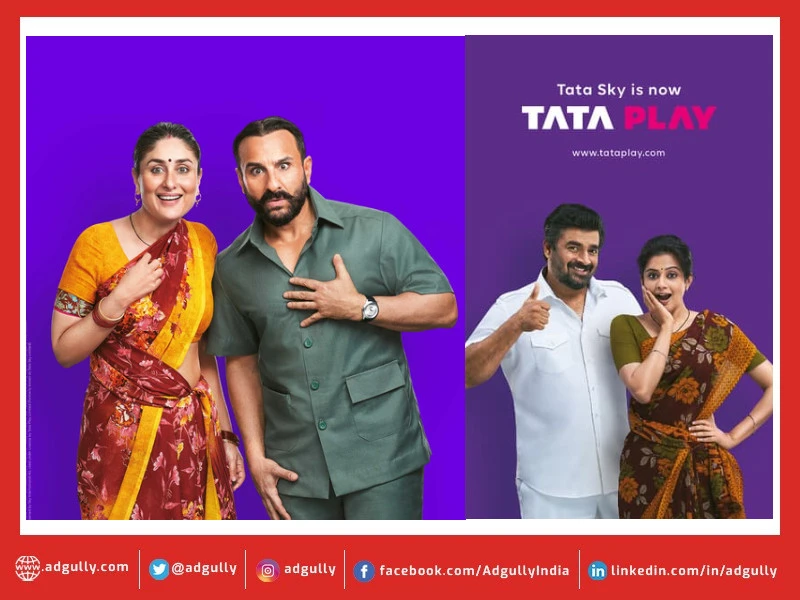I distinctly remember how I tried to convince my father to subscribe to Disney Channel so that I could watch Wizards of Waverly Place.
The next generation, who are brought up watching OTT platforms, won’t ever know how we used to switch between music channels to find a good song, wait for the repeat telecast of Tarak Mehta, and watch Roadies on MTV.
Like we won’t ever know how the previous generation only had Door Darshan as an option to watch on Television. In 2000s, the Direct-to-Home (DTH) television industry picked up pace, offering more channels and options to the user.
Though there were competitors, Tata Sky, now Tata Play, came to be a dominant player with a 33% market share in 2023. For the sake of brand recall, we’ll refer to the company as Tata Sky here.
The company also has one of the taglines I remember the most is – “Isko laga dala toh life jingalala”.
Market Landscape and Tata Sky
Tata Sky was established in 2006 in a joint venture between the Tata Group and 21st Century Fox in an 80-20 stake deal. Before that, Dish TV had launched a few years earlier in 2003, making it the first DTH provider in India, and it quickly gained popularity among Indian households seeking better television quality.
Airtel Digital TV, though it would come later, was another significant player on the horizon. Cable TV still dominated most of the country, but it faced issues like poor picture quality, limited channels, and unreliable service, especially in rural and remote areas.
Tata Sky entered the market to make the experience of watching television more enjoyable and reliable than ever before. It emphasized reliability, high-quality sound and picture, and top-notch customer service, setting itself apart as a trusted, premium brand.
The Tagline
In 2000s, the DTH market was still developing and consumer expectations were relatively simple. Tata Sky aimed to differentiate itself by promising superior quality, a diverse range of channels, and a premium service channel.
But these technical words meant nothing for the masses. So, it was communicated very colloquially and quirkily – “Isko Laga Dala Toh Life Jingalala”.
It’s relatable, catchy, and fun, capturing the sentiment that Tata Sky is an upgrade to an enjoyable and colorful life.
Why the tagline worked:
- Memorable and Catchy:
In a cluttered market, this catchy phrase helped the brand stick in consumers’ minds.
- Emotion Over Features:
Instead of focusing on technical aspects, Tata Sky chose to emphasize the emotional impact of its service – bringing joy and comfort to family viewing experiences.
- Broad Appeal:
The tagline resonates across demographics, appealing to urban and rural audiences, families, and individuals alike.
- Strong Brand Recall:
“Life Jingalala” created strong recall value. The slogan, paired with a series of engaging advertisements featuring popular Bollywood actors like Aamir Khan, embedded Tata Sky’s image as a fun, reliable, and high-quality service in the minds of consumers.
- Longevity:
The tagline has endured for years without losing its charm. Even with newer campaigns and innovations, “Life Jingalala” remains synonymous with Tata Sky’s brand, proving its versatility and strength.
This classic tagline made the brand memorable, even till this date.
Marketing Mix
Product:
One of Tata Sky’s most significant moves was its early focus on innovation. It was the first to offer services like Tata Sky+, a set-top box that allowed users to record shows, letting them watch their favorite shows at their own pace.
It also offers games that you can play (I used to play one of them as a kid, though I don’t remember the name of the game anymore :/). This makes the experience more engaging. A unique product is also their Acting Adda, where people could learn acting on television!
It offers various products through categories, including Tata Sky SD, Tata Sky HD, Tata Sky 4K, and Tata Sky Mobile App. Currently, its offerings have broadened with Tata Play.
Price:
Compared to its competitors, Tata Sky is premium and initially targeted metro cities. However, since 2008, it also started to penetrate outside these cities to make itself available pan India, and this is when it tweaked its pricing.
Tata Sky adopted a product line pricing strategy, offering different services at different price points. It also allows the customers an option to choose to pay for additional services on top of a base package. Some consumers found this expensive:

However, Tata Sky’s premium positioning and services made justified its pricing. They also used the a la carte (French for ‘from the menu’) television pricing model where customers can subscribe to and pay for only those individual channels that they like.
This flexibility allows Tata Sky to target budget-conscious users as well, with basic packs that include essential channels at an affordable price.
Place:
Tata Sky products and services are available through their website and mobile app, where customers can select packages, renew subscriptions, and access support through their 24×7 helpline without visiting a physical store.
Through partnerships with dealers and setting up numerous service centers, Tata Sky ensures that their products are accessible even in semi-urban and rural areas. They also have trained staff across the sales funnel to close the customers.
To encourage subscriptions outside major cities, they introduced daily recharge at Rs. 8, where customers could pay only for the day they watched the TV, as there were many power outages and electricity was not consistently available.
Though the DTH industry saw a decrease in the number of paying subscribers in the past year, Tata Sky still holds a dominant share with over 20.77 million subscribers.
However, where they were doing a profit of Rs. 20 Cr in 2023, they stooped to a loss of Rs. 247 Cr in 2024. (Source). Still, it has a wide network in over 2 lakh towns and 18 million+ connections across India.
Promotion:
Initially, Tata Sky invested in getting the word out through traditional channels. The promotion of the tagline was a core part of the strategy to create brand awareness and recall.
It also expanded rurally and created campaigns like this to promote it, implying that if a call can reach the place, Tata Sky can reach the place as well:
They also used celebrity endorsement with Amir Khan to promote their distinguishing factors through a humorous analogy:
In their promotions, they also use different languages like Hindi, Marathi, Telugu, Bengali, and Odia, among others, to have a local appeal through regional marketing. Another major campaign was centered around Tata Sky’s “Family Jingalala” package, which focused on the idea that Tata Sky had something for every member of the family.
They also have a strong social media presence. tataplay currently has 136K followers on Instagram. They appeal to the emotions through storytelling, entertaining, and relatable content.

This helps to engage Gen Z and millennial audience and stay on top of the mind of this demographic.
Rebranding Strategy
When streaming began to reshape media consumption habits, Tata Sky was quick to adapt. At the time, DTH services, while still popular, were facing pressure as viewers leaned toward streaming platforms, which offered more flexibility, variety, and on-demand access.
Driven by this changing landscape in content consumption, in 2022, Tata Sky rebranded itself as Tata Play.
Rather than competing directly with streaming services, Tata Play partnered with them, becoming a single access point for content consumption. It offered:
- Tata Play Binge:
Unified subscription for multiple OTT platforms and DTH content.
- Hybrid Set-Top Box:
Switch between live TV and OTT on a single device.
- Flexible Subscriptions:
Customizable plans to choose preferred DTH and OTT services.
- Simplified Billing:
Combined DTH and OTT billing for easier payments.
- Regional Content:
Expanded content in multiple Indian languages.
- New Brand Identity:
Fresh logo, appealing to younger viewers while keeping Tata’s legacy.
The rebranding to Tata Play was intended to communicate the brand’s evolution as a broader entertainment brand that could deliver both traditional TV and modern streaming experiences. This forward-thinking approach enabled Tata Sky to retain viewers who were shifting towards online content.
In a Nutshell
The customer-centric approach and memorable marketing campaigns helped Tata Sky build consumer loyalty. It managed to stay relevant, even as more consumers shifted away from traditional DTH services toward online streaming, through its rebranding.
By listening to market trends and expanding beyond its initial offering, Tata Play adapted to new audience behaviors and preferences.
Key Takeaways from Tata Sky’s Marketing
- Leverage Emotive Taglines:
A relatable, catchy tagline can significantly boost brand recall and consumer connection.
- Focus on Customer-Centric Innovation:
Offer unique features that enhance the user experience and solve real consumer pain points.
- Adapt to Changing Market Dynamics:
Stay relevant by recognizing shifts in consumer behavior.
- Use Regional Marketing for Wider Appeal:
Customizing campaigns by language and locality can help capture a diverse audience.
- Balance Premium Positioning with Flexibility:
Premium services combined with flexible pricing options can widen the customer base.


